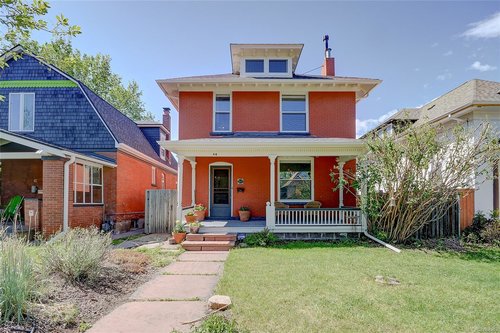Some cities have brownstones. Others have bungalows. In Denver, we have the Denver Square—a sturdy, symmetrical, and endlessly adaptable home style that’s quietly defined our streetscapes since the early 1900s.
These boxy, brick-clad houses have stood the test of time across neighborhoods like Congress Park, Platt Park, Park Hill, West Wash Park, and even the quieter pockets near DU. But lately, there’s a new twist to this classic: the rise of the ‘pop the top’ trend, where homeowners expand upward to add square footage while keeping that historic charm intact—at least on the main level.
Let’s talk about why these homes matter, what happens when we pop the top, and what it all means for the future of Denver’s neighborhoods.
🧱 What Is a Denver Square?
The “Denver Square” is a regional take on the American Foursquare—a post-Victorian, pre-modern style that exploded in popularity between 1890 and 1930. Known for their practical layouts, hipped roofs, and full-width front porches, these homes were designed to be functional and timeless.
In Denver, they’re typically made of brick, with boxy footprints and wide staircases leading up to grand entryways. Inside, you’ll often find four main rooms on each level, high ceilings, original woodwork, and that nostalgic blend of craftsmanship and simplicity that’s hard to replicate in new construction.

Denver Squares are especially concentrated in older neighborhoods like:
- Congress Park – where historic preservation meets modern living
- Platt Park – family-friendly charm with vibrant walkability
- Park Hill – broad boulevards and architectural variety
- West Wash Park – close to the park with high demand for thoughtful remodels
- University Neighborhoods – where many homes are being reimagined to meet growing needs
The Rise of the ‘Pop the Top’ Trend
Denver homeowners love their charm, but they also need more space. Enter the ‘pop the top’—a popular renovation move where a second story is added to an existing Denver Square.
Sometimes this is done with extreme sensitivity to the original aesthetic. Other times… less so.
The trend has taken off in areas with strong architectural bones but limited square footage. Think families who want to stay in central Denver but need more bedrooms, a home office, or a dedicated music studio.
Some common motivations behind popping the top include:
- Keeping your location without compromising on space
- Increasing long-term property value
- Modernizing older homes with energy-efficient systems and layouts
- Taking advantage of Denver’s strong resale market for updated, expanded historic homes
But here’s the catch: not every pop makes the neighborhood better. There’s an art to preserving the integrity of the original design while creating something new—and unfortunately, not every addition gets it right.
🏘️ What It Means for Denver Real Estate
The good news? Well-executed pop-tops add serious value. These properties often command a premium because they blend character with livability—and they tend to stand out in a sea of cookie-cutter builds.
The challenge? As more people look to renovate instead of relocate, we’re seeing increased pressure on local zoning laws, design review boards, and the architectural cohesion of beloved neighborhoods.
We’ve seen this story play out before. In my recent coverage of the Ball Arena redevelopment, the Colfax revitalization, and Cherry Creek’s luxury transformation, I’ve talked about how Denver is constantly evolving—always walking that line between progress and preservation.
The Denver Square and its many modern iterations are part of that story.
Final Thoughts
As someone who helps clients navigate historic homes, design-focused renovations, and investment-driven upgrades, I see both sides. The Denver Square is a cornerstone of our city’s architectural identity—and when treated with care, it can adapt beautifully to meet today’s needs.
Whether you’re thinking about buying a classic, expanding your footprint, or selling a home with potential, let’s talk about how to do it right. Smart, intentional design will always win—and in Denver’s hottest neighborhoods, that matters more than ever.
Because here, we don’t just build houses. We build stories worth preserving.
If you’re interested in exploring Denver Squares or curious about your neighborhood’s zoning for additions, I’m happy to share what I’ve learned—especially from recent transactions in Congress Park, DU, and Wash Park. Let’s make sure your next move is both beautiful and strategic.

 Facebook
Facebook
 X
X
 Pinterest
Pinterest
 Copy Link
Copy Link


